| ENVIS Technical Report: 90, April 2015 |
1Energy and Wetlands Research Group, Centre for Ecological Sciences,
2Centre for Sustainable Technologies (astra)
3 Centre for infrastructure, Sustainable Transportation and Urban Planning [CiSTUP],
Indian Institute of Science, Bangalore, Karnataka, 560 012, India
Web: http://ces.iisc.ac.in/energy
E Mail: cestvr@ces.iisc.ac.in; ganesh@ces.iisc.ac.in
Tel: 91-080-22933099, 2293 3503 extn 101, 107, 114
4Adamya Chetana, Annapoorna - Bangalore, Community Hall,
Kempegowda Nagar, Bengaluru, Karnataka 560019
Tel: 080 2662 0404, E Mail: tejaswini.acf@gmail.com
5
R K Mission, Shivanahalli, Anekal, Bangalore,
E Mail: vishnumayananda@gmail.com
*Corresponding author: cestvr@ces.iisc.ac.in
|
|
RAGIHALLI VILLAGE PANCHAYAT
Ragihalli panchayat is a cluster of 16 surrounding villages/hamlets with total population of 3119 from 738 households. Ragihalli is the biggest village followed by Shivanahalli with population 1052 and 736 respectively. Table 1 gives the population details of each village/hamlet in the panchayat.
Village is located in the undulating terrain where the elevation rages from about 700m to 950m. It experience annual rainfall of about 600 to 700 mm and has arid (dry) landscape with thin soil cover (rock beneath) in many places. Agriculture is the primary occupation in the village where Ragi is the major crop. Farmers grow oil seeds such as Castor, grains such as Buck wheat, Kidney beans (Avare) and also Grams, vegetables and flowers in irrigated lands. However, seasonal rain fed agriculture is practiced in the village due to non-availability of water during pre and post monsoon season. Ground water is available at more than 700 ft. which has gone up to 1000 ft. in few places. Village has a good livestock population with 894 cows, 959 sheep, 968 goats and 985 hen. Villagers also run two milk dairies in Ragihalli and Shivanahalli yet, many farmers are not owning high milk yielding cattle varieties. Reduction in fodder availability throughout the year and irregular payments in dairies are affecting cattle farming due to which villagers are not showing interest in having more high milk producing cattle.
Table 1: Village wise population details
Village |
Households |
Population |
Ragihalli |
185 |
1052 |
Annayyana Doddi |
58 |
172 |
Sevanayakana Doddi |
33 |
112 |
Ramanayakana Doddi |
37 |
170 |
Basavana Doddi |
10 |
48 |
Koratagere Doddi |
29 |
160 |
Moodlayyana Doddi |
23 |
60 |
Shivanahalli |
153 |
736 |
Ontemarana Doddi |
11 |
52 |
Sollepura Doddi |
58 |
92 |
Muninanjappana Doddi |
9 |
28 |
Gudlayyana Doddi |
8 |
40 |
Jaipura Doddi |
77 |
224 |
Kariyappana Doddi |
20 |
64 |
Ujinappana Doddi |
14 |
61 |
Kateri Doddi |
13 |
48 |
Total |
738 |
3119 |
All villages/hamlets in the panchayat are electrified where electricity is used for lighting and television operation. Few farmers have electrified irrigation pump sets. Cooking energy is mostly met by LPG connection. Rama Krishna mission (R K Misssion) of Shivanahalli is providing LPG cylinder to most of the villages. RKM Shivanahalli is continuously working for more than 3 decades for the betterment of villagers and restore forest patches in the elephant corridor to minimise the human-elephant conflict in the region. R K mission has also made significant contributions through a primary school and vocational training for the youths. There are 3 lower primary schools (1 to 5) and a higher primary school of which only school in Ragihalli (Higher primary) is functional (apart from school at RKM). There are about 4 kindergarten centre of which only one is functional yet there is no electricity and drinking water supply.
There is only one Ayurvedic health centre for more than 3000 villagers with a visiting doctor. Closest Primary Health Centre (PHC) is about 10km for the village which is not viable due to the lack public/private of transport facility. Alcoholism is a social evil in all villages, where few villagers operate the trading from home (without license). Lack of education, poverty and unemployment are aiding vandalism in the village especially in the current generation. Particulate matter of the air seems to be high in many villages due to crushing of stone in the quarry located in the vicinity. Regular blasting in the quarry caused breaks in walls of houses and damaged many structures. This also effected health of villagers where many of them suffering from respiratory and skin related diseases. Table 2 shows the sector wise status of the panchayat.
Table 2: Sector wise overview of the village
Sector |
Status |
Agriculture |
- Lack of water availability
- Mostly seasonal cropping in traditional manner
- Lands are being abandoned
|
Water resources |
- Reduced ground water table (> 700 ft.)
- Lack of water resource management
- No watershed management
|
Livestock |
- Low fodder availability
- Irregular payment in dairies
- No clinic
- Lack of cattle shed and maintenance
|
Health |
- No primary health centre
- Only ayurvedic health centre with part time doctor
- Respiratory diseases in villagers due to dust
|
Education |
- Only 2 schools for 16 villages
- No high school in the region
- Only one functioning kindergarten
|
Transportation |
- Many villages have no bus facility
- Lesser bus frequency
- Roads are being spoiled by heavily loaded quarry lorries
|
Energy |
- Electricity supply is not reliable
- Traditional stoves are being used for water heating
- Few household are yet to get LPG for cooking
|
Environment |
- Very less vegetation cover
- High particulate matter in the air due to quarry and blasting
- Low rainfall and arid land
|
Society |
- People are addicted alcohol
- Youths are migrating to nearby cities for job
- Lack of literacy, skill employment
|

Abandoned School at Shivanahalli
|

Heavy vehicle on roads
|

House with mud walls and fragile roof
|
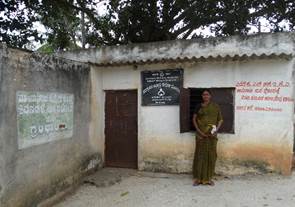
Kindergarten
|
Agriculture
Ragihalli village panchayat is an Agrarian economy where most of the families practice agriculture for their livelihood. The families without land work as agriculture labour and few people are dependent on jobs in the town. However, agriculture is the primary occupation in the village where Ragi is the major crop. Rain fed seasonal crop is grown by most of the farmers where more than 90% of the lands are not irrigated. Sericulture, oil seeds, grains, vegetables and flowers are grown in few irrigated lands in the village. Water availability throughout the year is a limiting factor for cropping, due to which many farmers have stopped growing Ragi in recent years and lands are left fallow.
Land Use in Ragihalli village panchayath |
Total Crop Land |
441.2 ha |

|
Irrigated Land |
21.5 ha |
Non-Irrigated Land |
419.67 ha |
Grass Land |
1147.83 ha |
Crop Grown |
- Ragi is the primary crop grown in the village.
- Most of the farmers practice rain fed (seasonal) cropping and water scarcity is prevalent in the region.
- Some farmers also practice sericulture and grow mulberry (for feed).
- Few farmers grow oil seeds such as Castor, grains such as Buck wheat, Kidney beans (Avare) and also Grams, vegetables and flowers in irrigated lands.
- Human animal conflict in the region as some region form corridor for wild animals. Agriculture fields closer to Bannerghatta National Park are kept fallow due to fear of crop raid by animals.
- Fodder scracity - low crop yield, and farmers are keen to dispose off livestock or not interested in high yield varieties .
- Migration of local youth to nearby towns (jobs in nindustries and commercial establishments)
- Air pollution: Higher concentration of particulate matter in the environment due to sustained granite mining (in nearby quarries- legal as well as illegal). Unscientific mining practices have dmamged properties (buildings, etc.) and also humans (respiratory and skin ailments).
|
  
Figure 4: Oil seeds and floriculture in irrigated lands
|

Figure 5: Quarry near the village
|
Quantity of water available during pre and post monsoon period is the limiting factor for agricutural, horticultural and sericultural activities. Rejuvination of water bodies and recharging of ground water resources have to be taken up on priority through micro-watershed management. |
Water Resources
The region receives annual rainfall of about 600 – 700mm. Agriculture and domestic requirement is met mainly by groundwater resources. There are about 15 bore wells in the region. An overhead water tank caters to the domestic water requirement of more than 700 households in 16 villages. Lack of watershed management with appropriate recharging mechanism has led to the decline of groundwater table, evident from the Ground water table of 700 feet and even some bore wells have crossed 1000 feet. Water for domestic use is also supplied at a common location through taps, for a cluster of 8-10 houses, which is available once in 2 or 3 days. Water is stored at few houses in underground sumps and also in big containers or drums. Water scarcity has affected the livelihood due to lack of agriculture and horticulture produce in the region.
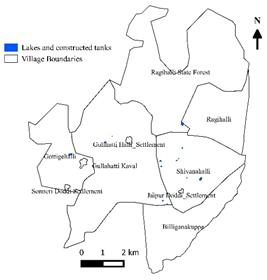 |

|
Ragihalli Lake |
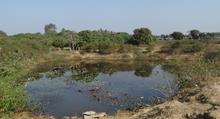
|
Shivanahalli Lake |
Figure 6: Waterbodies in the village
There are few lakes and constructed tanks in and around the panchayat. But most of these lakes and tanks are not maintained, which necessitates restoration of lakes and treatment of respective lake’s catchment/watershed (watershed management involving local community). Only, few lakes (such as Shivanahlli Lake) are in good condition. Rejuvenation and sustainable management of water bodies (lakes and tanks) with participation of local community will only solve the water scarcity in the region through sustained recharge of groundwater sources.
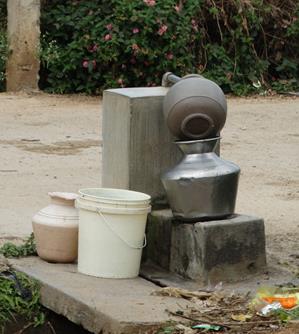 |
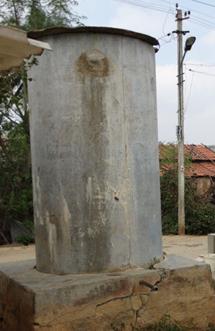
|
Figure 7: Common tap fecility |
Figure 8: Community water storage tank |
Intervention: Approaches towards sustainable agriculture
- Rain water harvesting (tanks, recharge pits) and micro watershed management (ecological: planting of appropriate native species of grass and trees, engineering: check dams, gully traps, etc.) has to be done on priority.
- Percolation tanks, lakes, check dams and bunds should be constructed considering stream network and topography.
- Annual rainfall of 600-700 mm is adequate to meet the basic needs (domestic, agriculture, horticulture), which entails rainwater harvesting through tanks and recharges pits apart from interventions at micro watershed levels.
- Selection of crop variety depending on water availability during the respective season: Crops requiring lower quantum of water to be introduced as a second crop and also some horticulture crops could elevate the economic status. Table 3 gives the water requirement for various cropping species. However, this also requires village knowledge centre to advice the farmers on crop selection, fertiliser input, etc.
- Planting of grass species along slopes and in fallow lands – provides slope stability as well as helps in water percolation during rainy seasons
- Growing fodder crop during lean season (agriculture) would help in adding nutrients to the soil and also helps in addressing fodder scarcity issues in the region.
- Medicinal plants and horticulture crops with mango, neem, pongamia and tamarind trees (to strengthen bund and yield fruits) on the banks, would empower local community with additional revenue.
- Planting of trees such as Mango (Mangifera indica), Ashoka (Polyalthia longifolia), Pongamia (Derris indica) and Umbrella - Thespepsia populnea near homes act as dust barriers.
- Develop Farmers Information System (FIS). This involves digitising all land records and development of information system (with attribute details such as ownership, spatial extent, etc.). Geo-tagging land records would help in curtailing unauthorised occupation of common lands (common property resources). This will help in monitoring the land use as well as crop yield, etc. Farmers’ information system equipped with information such as soil quality, quantity of fertiliser application, irrigation quantum would help in the sustainable management of natural resources.
- Introduce drip irrigation in agriculture and horticulture fields to conserve and effective use of water. Crop water consumption should be monitored and farmers’ information system (FIS) to provide information to farmers on excess water utilisation which may also be communicated through automated SMS.
- Facility FIS- Farmers’ Information system would also provide job opportunity to the local educated youth as management of FIS requires regular data acquisition, updation and responding to farmer’s queries, interfacing with government agencies (agriculture officer, village accountant, etc.). Panchayat (with the funds allocated for local MLA) to provide necessary infrastructure and financial support to set up the server, develop database and continuous updation and maintenance.
- FIS shall also have facility for water and soil quality testing. The provision of soil testing facility as part of FIS would help in developing location specific information which helps in advising farmers on the type and quantity of fertiliser requirement, soil health etc. Village youths may be trained to carryout soil and water testing.
- Vocational training programmes to farmers about organic farming, organic fertiliser preparation and marketing, vermicomposting, food processing etc.
Table 3: Water requirement for different crops
Crop |
Benefits |
Average water requirement (million litres/ha/season) |
Ragi and other millets |
Food crop and sold in the market
Self-reliance on food |
10.7 |
Sericulture |
High market value |
0.34 |
Oil seeds |
High market value |
5 - 8 |
Subabul (Leucaena leucocephala) |
High energy value
Can be used in bio-gasifiers |
4.1 |
Pongamia (Pongamia pinnata) |
Oil extracted can be used in bio-diesel production |
|
Jatropa (Jatropha curcas) |
Bio-fuel production |
|
Fodder farm |
Cattle food |
10 |
Floriculture |
Can be exported to nearby towns |
|
Benefits: Multi-cropping practice with drip irrigation would be the necessary intervention in the region. This will have many benefits such as;
- Job to rural youth and all villagers irrespective of age group throughout the year;
- Revenue due to multi-cropping;
- Soil fertility increases with the proper choice of crop (leguminous crop during lean seasons would help in enriching soil of nutrients and also require less water)
- Optimum utilisation of available land.
- Efficient management of water through drip irrigation
- Higher fodder and biomass production from crop residue
- Supports livestock - cattle farming and manure production
- Scope for food processing industry in the region
- Entrepreneurship opportunities through marketing of agro-products and possibility of setting up agro-processing industries of castor oil, Ragi malt and powder, Ragi biscuits, etc.
|
Dr. T.V. Ramachandra
Centre for Sustainable Technologies, Centre for infrastructure, Sustainable Transportation and Urban Planning (CiSTUP), Energy & Wetlands Research Group, Centre for Ecological Sciences, Indian Institute of Science, Bangalore – 560 012, INDIA.
E-mail : cestvr@ces.iisc.ac.in
Tel: 91-080-22933099/23600985,
Fax: 91-080-23601428/23600085
Web: http://ces.iisc.ac.in/energy
Ganesh HegdeEnergy & Wetlands Research Group, Centre for Ecological Sciences, Indian Institute of Science, Bangalore – 560 012, INDIA.
E-mail: ganesh@ces.iisc.ac.in
Subhash Chandran M.D.Energy & Wetlands Research Group, Centre for Ecological Sciences, Indian Institute of Science, Bangalore – 560 012, INDIA.
E-mail: mds@ces.iisc.ac.in
Tejaswini Ananth KumarAdamya Chetana, Annapoorna - Bangalore, Community Hall,
Kempegowda Nagar, Bengaluru, Karnataka 560019
E-mail: tejaswini.acf@gmail.com
Vishnumayananda SwamijiR K Mission, Shivanahalli, Anekal, Bangalore
E-mail: vishnumayananda@gmail.com
Citation:Ramachandra T V, Ganesh Hegde, Subash Chandran M D, Tejaswini Ananth Kumar and Vishnumayananda Swamiji, 2015., SMART Ragihalli: Effort towards Self-reliant & Self-sufficient system empowering Man power (rural youth) with Appropriate Rural Technologies,ETR 90, Energy & Wetlands Research Group, CES, Indian Institute of Science , Bangalore
| Contact Address : |
| |
Dr. T.V. Ramachandra
Energy & Wetlands Research Group,
Centre for Ecological Sciences, TE 15, New Biology Building, Third Floor, E Wing, [Near D Gate], Indian Institute of Science, Bangalore – 560 012, INDIA.
Tel : 91-80-22933099 / 22933503-extn 107
Fax : 91-80-23601428 / 23600085 / 23600683 [CES-TVR]
E-mail : cestvr@ces.iisc.ac.in, energy@ces.iisc.ac.in,
Web : http://wgbis.ces.iisc.ac.in/energy |
| |













